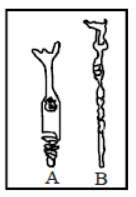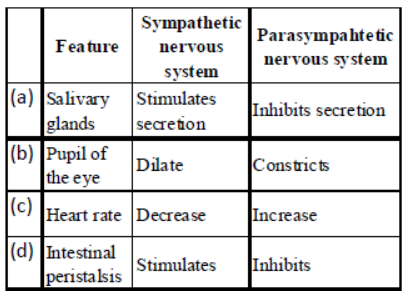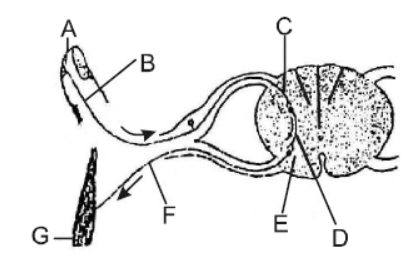Read and download free pdf of CBSE Class 11 Biology Neural Control and Coordination Worksheet Set A. Download printable Biology Class 11 Worksheets in pdf format, CBSE Class 11 Biology Chapter 21 Neural Control and Coordination Worksheet has been prepared as per the latest syllabus and exam pattern issued by CBSE, NCERT and KVS. Also download free pdf Biology Class 11 Assignments and practice them daily to get better marks in tests and exams for Class 11. Free chapter wise worksheets with answers have been designed by Class 11 teachers as per latest examination pattern
Chapter 21 Neural Control and Coordination Biology Worksheet for Class 11
Class 11 Biology students should refer to the following printable worksheet in Pdf in Class 11. This test paper with questions and solutions for Class 11 Biology will be very useful for tests and exams and help you to score better marks
Class 11 Biology Chapter 21 Neural Control and Coordination Worksheet Pdf
MULTIPLE CHOICE QUESTIONS
Question. Sensation of stomach pain is due to
(a) interoceptors
(b) exteroceptors
(c) teloreceptors
(d) all of these
Answer. A
Question. Which is the example of conditioned reflex ?
(a) Eyes closed when anything enter into it.
(b) Hand took up when piercing with needle.
(c) Salivation in a hungry dog in response to ringing of a bell.
(d) Digestion food goes forward in alimentary canal.
Answer. C
Question. Excessive stimulation of vagus nerve in humans may lead to
(a) hoarse voice
(b) peptic ulcers
(c) efficient digestion of proteins
(d) irregular contraction of diaphragm
Answer. D
Question. A person is wearing spectacles with concave lenses for correcting vision. While not using the glasses, the image of a distant object in his case will be formed
(a) on the blind spot
(b) behind the retina
(c) in front of the retina
(d) on the yellow spot
Answer. C
Question.Unidirectional transmission of a nerve impulse through nerve fibre is due to the fact that
(a) nerve fibre is insulated by a medullary sheath.
(b) sodium pump starts operating only at the cyton and then continues into the nerve fibre.
(c) neurotransmitters are released by dendrites and not by axon endings.
(d) neurotransmitters are released by the axon endings and not by dendrites.
Answer. D
Question. Examine the diagram of the two cell types A and B given below and select the correct option:

(a) Cell A is the rod cell found evenly all over retina.
(b) Cell A is the cone cell more concentrated in the fovea centralis.
(c) Cell B is concerned with colour vision in bright light.
(d) Cell A is sensitive to low light intensities.
Answer. B
Question. A person, who shows unpredictable moods, outbursts of emotion, quarrelsome behaviour and conflicts with others, is suffering from
(a) borderline personality disorder (BPD)
(b) mood disorder
(c) addictive disorder
(d) schizophrenia
Answer. A
Question. Which of the following is an eye disease?
(a) hepatitis
(b) measles
(c) glaucoma
(d) bronchitis
Answer. C
Question. Given below is a table comparing the effects of sympathetic and parasympathetic nervous system for four features (1-4).
Which one feature is correctly described?

Answer. B
Question. The black pigment in the eye which reduces the internal reflection is located in
(a) retina
(b) iris
(c) cornea
(d) sclerotic
Answer. A
Question. Bipolar nerve cells are present in
(a) Skin tactile corpuscles
(b) Spinal cord
(c) Retina of eye
(d) All the above
Answer. C
Question. Which of the following ions are required for nerve conduction ?
(a) Ca++, Na+ and K+
(b) Ca++ and Mg++
(c) Mg++ and K+
(d) Na+ and K+
Answer. A
Question. The following diagram indicates the reflex arc.
Identify the parts labelled as A, B, C, D, E, F and G. Choose the correct option

(a) A = sense organ; B = sensory nerve;
C = dorsal horn;
D = interneuron; E = ventral horn;
F = motor nerve; G = effector
(b) A = sense organ; B = sensory nerve;
C = ventral horn;
D = interneuron; E = dorsal horn;
F = motor nerve; G = effector
(c) A = effector; B = motor nerve;
C = dorsal horn;
D = interneuron; E = ventral horn;
F = sensory nerve; G = effector
(d) A = effector; B = motor nerve;
C = ventral horn; D = interneuron;
E = dorsal horn; F = sensory nerve;
G = sense organ.
Answer. A
ASSERTION REASON QUESTIONS
Directions : Each of these questions contains an Assertion followed by Reason. Read them carefully and answer the question on the basis of following options. You have to select the one that best describes the two statements.
(a) If both Assertion and Reason are correct and Reason is the correct explanation of Assertion.
(b) If both Assertion and Reason are correct, but Reason is not the correct explanation of Assertion.
(c) If Assertion is correct but Reason is incorrect.
(d) If both the Assertion and Reason are incorrect.
Question. Assertion : The brain stem contains centres for controlling activities.
Reason : Brain stem is very sensitive.
Answer. B
Question. Assertion : The chemical stored in the synaptic vesicles are termed as neurotransmitters.
Reason : Synaptic vesicles release these chemicals in the synaptic cleft.
Answer. B
Question. Assertion: The imbalance in concentration of Na+, K+ and proteins generates resting potential.
Reason: To maintain the unequal distribution of Na+ & K+, the neurons use electrical energy.
Answer. C
Question. Assertion : The axonal membrane of the neuron is more permeable to sodium ion (Na+) and nearly impermeable to potassium (K+).
Reason : In a resting state neuron does not conduct any impulse.
Answer. D
Question. Assertion : A cerebellum is related with skillful voluntary movement and involuntary activity like body balance, equilibrium, etc.
Reason : It is part of hind brain and it is situated behind the pons.
Answer. B
Please click the link below to download CBSE Class 11 Biology Neural Control and Coordination Worksheet Set A
| CBSE Class 11 Biology Locomotion And Movement Worksheet Set C |
| CBSE Class 11 Locomotion and Movement Worksheet A |
| CBSE Class 11 Locomotion and Movement Worksheet B |
Chapter 21 Neural Control and Coordination CBSE Class 11 Biology Worksheet
The above practice worksheet for Chapter 21 Neural Control and Coordination has been designed as per the current syllabus for Class 11 Biology released by CBSE. Students studying in Class 11 can easily download in Pdf format and practice the questions and answers given in the above practice worksheet for Class 11 Biology on a daily basis. All the latest practice worksheets with solutions have been developed for Biology by referring to the most important and regularly asked topics that the students should learn and practice to get better scores in their examinations. Studiestoday is the best portal for Printable Worksheets for Class 11 Biology students to get all the latest study material free of cost. Teachers of studiestoday have referred to the NCERT book for Class 11 Biology to develop the Biology Class 11 worksheet. After solving the questions given in the practice sheet which have been developed as per the latest course books also refer to the NCERT solutions for Class 11 Biology designed by our teachers. After solving these you should also refer to Class 11 Biology MCQ Test for the same chapter. We have also provided a lot of other Worksheets for Class 11 Biology which you can use to further make yourself better in Biology.
You can download the CBSE Practice worksheets for Class 11 Biology Chapter 21 Neural Control and Coordination for the latest session from StudiesToday.com
Yes, the Practice worksheets issued for Chapter 21 Neural Control and Coordination Class 11 Biology have been made available here for the latest academic session
There is no charge for the Practice worksheets for Class 11 CBSE Biology Chapter 21 Neural Control and Coordination you can download everything free
Regular revision of practice worksheets given on studiestoday for Class 11 subject Biology Chapter 21 Neural Control and Coordination can help you to score better marks in exams
Yes, studiestoday.com provides all the latest Class 11 Biology Chapter 21 Neural Control and Coordination test practice sheets with answers based on the latest books for the current academic session

